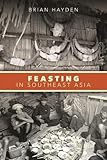Feasting in Southeast Asia / Brian Hayden.
Material type: TextPublisher: Honolulu : University of Hawaii Press, [2016]Copyright date: ©2016Description: 1 online resource (336 p.) : 92 b&w illustrationsContent type:
TextPublisher: Honolulu : University of Hawaii Press, [2016]Copyright date: ©2016Description: 1 online resource (336 p.) : 92 b&w illustrationsContent type: - 9780824856267
- 9780824856298
- 263/.90959 23
- GT4876.5 .H39 2016eb
- online - DeGruyter
- Issued also in print.
| Item type | Current library | Call number | URL | Status | Notes | Barcode | |
|---|---|---|---|---|---|---|---|
 eBook
eBook
|
Biblioteca "Angelicum" Pont. Univ. S.Tommaso d'Aquino Nuvola online | online - DeGruyter (Browse shelf(Opens below)) | Online access | Not for loan (Accesso limitato) | Accesso per gli utenti autorizzati / Access for authorized users | (dgr)9780824856298 |
Frontmatter -- Contents -- Acknowledgments -- List of Illustrations -- 1. The Fundamentals of Feasts -- 2. Hill Tribes in General -- 3. The Akha, "Rife with Feasts" -- 4. Tribal Feasting in Vietnam -- 5. Laotian Tribal Feasts -- 6. The Remarkable Torajan Feasting Complex -- 7. The Sumban Megalithic Feasting Complex -- 8. Conclusions: Explaining Feasts -- References Cited -- Index
restricted access online access with authorization star
http://purl.org/coar/access_right/c_16ec
Feasting has long played a crucial role in the social, political, and economic dynamics of village life. It is far more than a gustatory and social diversion from daily work routines: alliances are brokered by feasts; debts are created and political battles waged. Feasts create enormous pressure to increase the production of food and prestige items in order to achieve the social and political goals of their promoters. In fact, Brian Hayden argues, the domestication of plants and animals likely resulted from such feasting pressures. Feasting has been one of the most important forces behind cultural change since the end of the Paleolithic era. Feasting in Southeast Asia documents the dynamics of traditional feasting and the ways in which a bewildering array of different types of feasts benefits hosts. Hayden argues that people's ability to marry, reproduce, defend themselves against threats and attacks, and protect their interests in village politics all depend on their ability to engage in feasting networks. To be excluded from such networks means to be subject to attack by social predators, perhaps even leading to enslavement. As an archaeologist, Hayden pays specific attention to the materials involved in feasting and how feasting might be identified and interpreted from archaeological remains. His conclusions are based on his own ethnographic field studies in Thailand, Laos, Vietnam, and Indonesia, as well as a comparative overview of the regional literature on feasting. Hayden gives particular attention to the longhouses of Vietnam, an unusual but important social unit that hosts feasts, in an attempt to understand why they became established.This unique volume is the culmination of fifteen years of fieldwork among tribal groups in Southeast Asia. Until now no one has examined feasting as a general phenomenon in Southeast Asia or tried to synthesize its underlying dynamics from a theoretical perspective. The book will be of interest to cultural anthropologists, archaeologists, historians, and others involved in food studies.
Issued also in print.
Mode of access: Internet via World Wide Web.
In English.
Description based on online resource; title from PDF title page (publisher's Web site, viewed 29. Jul 2021)


